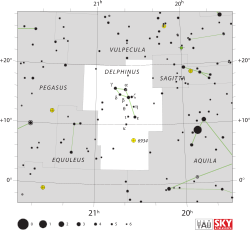Epsilon Delphini
| Epsilon Delphini (ε) | |
 | |
| Observationsdata Epok: J2000.0 | |
|---|---|
| Stjärnbild | Delfinen |
| Rektascension | 20t 33m 12,77192s[1] |
| Deklination | +11° 18′ 11,7412″[1] |
| Skenbar magnitud () | +4,03 ± [2](3,95 – 4,05)[3] |
| Stjärntyp | |
| Spektraltyp | B6 III[4] |
| U–B | -0,46[2] |
| B–V | -0,13[2] |
| Variabeltyp | Misstänkt[3] |
| Astrometri | |
| Radialhastighet () | -19,4 ± 0,7[5] km/s |
| Egenrörelse (µ) | RA: +11,96[1] mas/år Dek.: -28,97[1] mas/år |
| Parallax () | 9,87 ± 0,21[1] |
| Avstånd | 330 ± 7 lå (101 ± 2 pc) |
| Absolut magnitud () | -0,06[6] |
| Detaljer | |
| Radie | 4,6[7] R☉ |
| Luminositet | 676[8] L☉ |
| Temperatur | 13 614 ± 15[7] K |
| Metallicitet | +0,08 ± 0,10[9] dex |
| Vinkelhastighet | +52 ± 4[10] km/s |
| Andra beteckningar | |
| Aldulfin, ε Del, 2 Delphini, BD+10° 4321, FK5 768, HD 195810, HIP 101421, HR 7852, SAO 106230[11] | |
Aldulfin[12] eller Epsilon Delphini (ε Delphini, förkortat Epsilon Del, ε Del) är en ensam stjärna[13] belägen i den mellersta delen av stjärnbilden Delfinen. Den har en skenbar magnitud på 4,03[2], är synlig för blotta ögat där ljusföroreningar ej förekommer. Baserat på parallaxmätning inom Hipparcosuppdraget på ca 9,9[1] mas, beräknas den befinna sig på ett avstånd på ca 330 ljusår (ca 101 parsek) från solen. På det beräknade avståndet minskar stjärnans skenbara magnitud med 0,11[6] enheter genom skymning orsakad av interstellärt stoft. Stjärnan flyttar sig närmare solen med en radiell hastighet av ca 19 km/s.[5]
Nomenklatur[redigera | redigera wikitext]
Epsilon Delphini har det traditionella arabiska namnet ðanab ad-dulfīn eller Dzaneb al Delphin, som angavs i stjärnkatalogen i Al Achsasi Al Mouakket-kalendern och som översattes till latin som Cauda Delphini, som betyder "delfinens stjärt".[14]
År 2016 anordnade International Astronomical Union en arbetsgrupp för stjärnnamn (WGSN)[15] med uppgift att katalogisera och standardisera riktiga namn för enskilda stjärnor. WGSN fastställde namnet Aldulfin för Epsilon Delphini i september 2017 och det ingår nu i IAU:s Catalog of Star Names.[12]
Egenskaper[redigera | redigera wikitext]
Epsilon Delphini är en blå till vit jättestjärna av spektralklass B6 III[4]. Den har en radie som är ca 4,6[7] gånger större än solens och utsänder från dess fotosfär ca 676[8] gånger mera energi än solen vid en effektiv temperatur av ca 13 600[7] K. Stjärnan kan vara något variabel, ibland ljusare ner till magnitud 3,95. [3]
Referenser[redigera | redigera wikitext]
- Den här artikeln är helt eller delvis baserad på material från engelskspråkiga Wikipedia, tidigare version.
Noter[redigera | redigera wikitext]
- ^ [a b c d e f] van Leeuwen, F. (2007), "Validation of the new Hipparcos reduction", Astronomy and Astrophysics, 474 (2): 653–664, arXiv:0708.1752, Bibcode:2007A&A...474..653V, doi:10.1051/0004-6361:20078357.
- ^ [a b c d] Crawford, D. L.; et al. (1971), "Four-color, H-beta, and UBV photometry for bright B-type stars in the northern hemisphere", The Astronomical Journal, 76: 1058, Bibcode:1971AJ.....76.1058C, doi:10.1086/111220.
- ^ [a b c] Samus, N. N.; et al. (January 2017), "General Catalogue of Variable Stars", Astronomy Reports, GCVS 5.1, 61 (1): 80–88, Bibcode:2017ARep...61...80S, doi:10.1134/S1063772917010085.
- ^ [a b] Lesh, Janet Rountree (December 1968), "The Kinematics of the Gould Belt: an Expanding Group?", Astrophysical Journal Supplement, 17: 371, Bibcode:1968ApJS...17..371L, doi:10.1086/190179.
- ^ [a b] Gontcharov, G. A. (November 2006), "Pulkovo Compilation of Radial Velocities for 35495 Hipparcos stars in a common system", Astronomy Letters, 32 (11): 759–771, arXiv:1606.08053, Bibcode:2006AstL...32..759G, doi:10.1134/S1063773706110065.
- ^ [a b] Gontcharov, G. A. (November 2012), "Spatial distribution and kinematics of OB stars", Astronomy Letters, 38 (11): 694–706, arXiv:1606.09028, Bibcode:2012AstL...38..694G, doi:10.1134/S1063773712110035.
- ^ [a b c d] Underhill, A. B.; et al. (November 1979), "Effective temperatures, angular diameters, distances and linear radii for 160 O and B stars", Monthly Notices of the Royal Astronomical Society, 189: 601–605, Bibcode:1979MNRAS.189..601U, doi:10.1093/mnras/189.3.601.
- ^ [a b] McDonald, I.; et al. (2012), "Fundamental Parameters and Infrared Excesses of Hipparcos Stars", Monthly Notices of the Royal Astronomical Society, 427 (1): 343–57, arXiv:1208.2037, Bibcode:2012MNRAS.427..343M, doi:10.1111/j.1365-2966.2012.21873.x.
- ^ Wu, Yue; et al. (January 2011), "Coudé-feed stellar spectral library - atmospheric parameters", Astronomy and Astrophysics, 525: A71, arXiv:1009.1491, Bibcode:2011A&A...525A..71W, doi:10.1051/0004-6361/201015014.
- ^ Bailey, J. D.; Landstreet, J. D. (2013), "Abundances determined using Si ii and Si iii in B-type stars: Evidence for stratification", Astronomy & Astrophysics, 551: A30, arXiv:1301.3050, Bibcode:2013A&A...551A..30B, doi:10.1051/0004-6361/201220671.
- ^ "eps Del -- Variable Star", SIMBAD Astronomical Database, Centre de Données astronomiques de Strasbourg, hämtad 2017-06-28.
- ^ [a b] "Naming Stars". IAU.org. Hämtad 16 december 2017.
- ^ Eggleton, P. P.; Tokovinin, A. A. (September 2008), "A catalogue of multiplicity among bright stellar systems", Monthly Notices of the Royal Astronomical Society, 389 (2): 869–879, arXiv:0806.2878, Bibcode:2008MNRAS.389..869E, doi:10.1111/j.1365-2966.2008.13596.x.
- ^ Knobel, E. B. (June 1895), "Al Achsasi Al Mouakket, on a catalogue of stars in the Calendarium of Mohammad Al Achsasi Al Mouakket", Monthly Notices of the Royal Astronomical Society, 55: 429–438, Bibcode:1895MNRAS..55..429K, doi:10.1093/mnras/55.8.429.
- ^ "IAU Working Group on Star Names (WGSN)". Hämtad 22 maj 2016.
Externa länkar[redigera | redigera wikitext]
| |||||||||||||||||||





